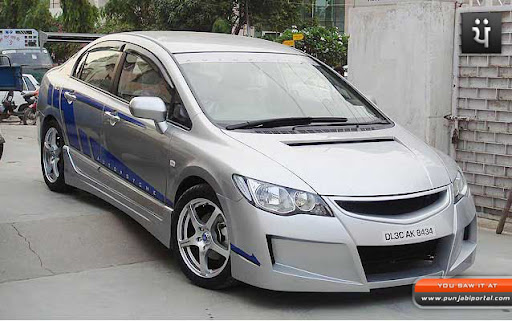The first Honda City (AA for sedans, VF for vans and FA for the wider Turbo II and Cabriolets) was created in November 1981 with the impressive "Tallboy" design; of unconventional height it empowered four adults to match comfortably in the very short City (under 3.4 m or 11.2 foot). Produced as a 3-door hatchback in a variety of trim levels, the town was also available together with the Motocompo, a particular 50cc 'foldaway' scooter designed to easily fit into the City's small suitcases area. During its introduction, it was Honda's smallest car, while not being in compliance with Japanese Administration kei regulations. It was much longer than the Honda N360 by 383 millimetres (15.1 in), but shorter than the Honda Civic first technology by 171 millimetres (6.7 in).
In September 1982 the Honda City Turbo was launched. It was powered by a turbocharged version of the 1231 cc Honda ER engine. A Pininfarina designed drop-top Cabriolet used the wider fenders and bigger bumpers of the Turbo II "Bulldog", but was only normally available with the naturally aspirated 67 PS (49 kW) engine motor. There was also a Pro-series of van versions with either two or four seats. A high-roof "R Manhattan Roof" version with a 10 cm taller roof covering also appeared.
Exports of the town were mostly to European countries (where it was renamed Honda Jazz, anticipated to Opel having trademarked the town name), Australia (in two-seater 'vehicle' form, to circumvent Australian transfer restrictions on passenger vehicles at that time) and New Zealand (where it was locally constructed). Production finished in late 1986 with the introduction of the GA type City.
The fifth technology Honda City was presented in Bangkok, Thailand in Sept 2008 accompanied by launches in India, Pakistan, Malaysia, Indonesia, Philippines, Singapore and China (Guangzhou Honda) in the following months. It really is manufactured in number of locations including Turkey, Thailand, Brazil and pakistan.
Based on market conditions, the populous city is available in a range of engine motor and specs levels. Generally in Asian markets the populous city will come in three variants - S, V and SV models. In a few market segments the SV and V is replaced by the E. For South America the DX is included by the range, LX, EX, and EXL models.
The range of four-cylinder engines include a 1.3 producing 73 kW (98 hp) at 6,000 rpm, a 1.5 engine unit placing out 120 PS (88 kW), which both can be purchased in manual and automated transmissions (Indonesia) and a 1.8-liter R18A engine (China market segments only).
In South America the range is offered with the i-VTEC 1.5-liter flex-fuel engine motor that is distributed to the Brazilian Honda Fit. The energy result is 115 horsepower with petrol and 116 horsepower using ethanol. Automatic and manual gearboxes are available.
In the Philippines, the 5th era City premiered in 2009 2009 available in 2 trims: 1.3 S and 1.5 E. The 1.3 liter comes in 5 acceleration manual or 5 rate automatic while the E variant is merely available in 5 swiftness automated with paddle shifters.
The populous city was quickly offered in picked European countries including Poland with a 1.4-litre i-VTEC engine mated to either a 5-speed manual or a 6-speed i-SHIFT automated manual transmission.
In November 2008 since it was launched in India, the City became the best-selling model of the company in the country, with sales volume level even surpassing that of Thailand, the best selling market for the City recently. The Honda City has been the leader in the premium mid-sized sedan segment for a decade, with 35% market share in 2010 2010.
In February 2009, Honda Australia have released the Thai-made City in to the Australian market in two 1.5-litre variants VTi-L) and (VTi. According to Honda Australia's boss, Yasuhide Mizuno, the populous city will compete with other light sedans like the Japanese built Toyota Yaris, the Korean-made Holden Barina and the Nissan Tiida (also Thai). This would be the first City released in Australia since the 1980s. It replaces the formerly smaller-sized Civics.
The City was launched in 2011 in South Africa as the Ballade, to match below the Civic and above the Jazz (Fit) sold there.In 2011 September, Honda Auto (Thailand) Ltd exposed the revamped Honda City, with new front grille design, new front and rear end bumpers, new taillamps design, new alloy rims, eco driving indicator and dual front side airbags to every model. In Dec 2011 including five variations - Corporate the modified model premiered in India, E, S, V and V (Sunroof) - and increased surface clearance to 165mm (recently 160mm) and also span increased by 20mm.Honda Vehicles Philippines launched the facelift version of the populous city in early on 2012. It has a redesigned front grille, front and rear bumper and new alloy wheels for the 1.5 E version, blue illumination measure and silver accent air conditioning change. In 2013, a new designed alloy tires for both 1.3 and 1.5 variants and a color of the town has been replaced Habanero Red has been replaced with Carnelian Red for the town. A Modulo version comes in both variations and in 2013 a Mugen version is available for the 1.5 variant only.Honda Siel Automobiles India the Indian subsidiary of Honda Motors has launched the facelifted Honda City 2012 in India. The new Honda City 2012 premiered in India in seven variants. All variants are run by the same 1.5 litre i-VTEC petrol engine which offers 118PS of vitality with 146Nm of maximum torque. Also, the company was organized to establish the Honda City diesel variations in the local market, which was launched in past due 2012. Here is the list of Honda City petrol models using their respective features.
http://www.honda-cirebon.netRelated Images with Honda City Type II Psychedelic
Honda City Modified Honda City Vtec 2003

09 modified honda City,,,,,Mugen RR 107462

Tidak ada komentar:
Posting Komentar